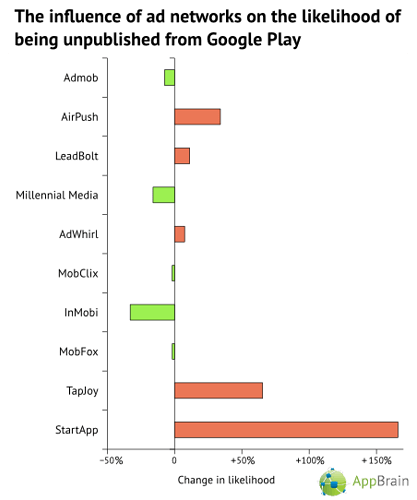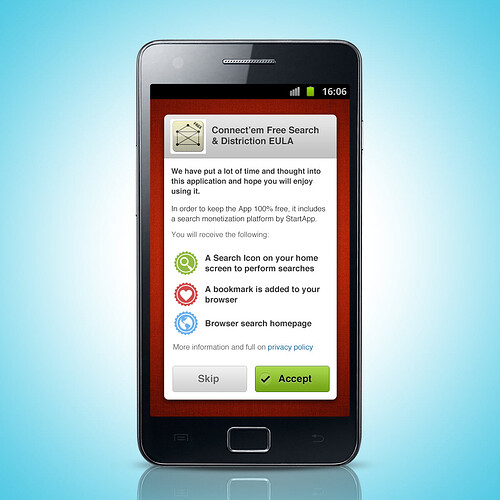No, I was just basing it on a reading of this thread.
While I can understand the bookmark placement and possibly also the home page change in the web browser (I don’t see why a user in his right mind would WANT to change that ?), what does it mean when an SDK is resident on the phone ?
I mean there is some reference to the SDK “already” being installed on the phone already. Does this suggest some active service remains running on phones (even after shortcuts, bookmarks been removed by the user) ?
Or is it just a marker places in preferences etc. - which StartApp just checks to see if it has been installed previously on this phone.
Presumably paying slightly less in such a scenario is reflecting that the user is “hostile” and may not keep the shortcuts again - OR is not hostile and has kept the shortcuts (in which case there is no value added for StartApp).
It is an interesting model - again however it is reminiscent of Leadbolt/Airpush notification ads - as the developer is the front for installation of something over which the developer has little insight (or ability to reverse from within the app).
However, it may be something that “works” in practice.
I wonder though if the “changes” it makes - while being legitimized by the EULA - still provide no “off” switch for the user. For notification ads - newer Android versions have capability of shutting off those in some way - or Google new requirements force there to be an identification “who the notification is coming from - what is the offending app”.
With bookmark changes - this may fall awry of Google “eventually” - as it steps on the search business for one - but secondly there being no way to undo the bookmark changes (as a whole). However, I acknowledge that the bookmarks inserted and the home page change could all be tackled individually by users. And the home screen shortcut is probably ok in that respect as well as it clearly identifies it as a “StartApp” shortcut.
Ideally there would be an undo icon on screen which would undo all the StartApp changes as well. However I can see how that would totally negate the value proposition for StartApp.
Which in a way also highlights that the value proposition IS essentially based on “friction” i.e. user will not bother (or know of) an easy way to undo everything.
Such a thing does not exist with incentivized installs for instance - as the app the user downloads is completely reversible.
However I can see where developers may find value in what you provide - in any case it is novel and probably the only option for app download-based revenue.
Thanks for your comments.
[hr]
StartApp representative,
Actually I just read that Lookout Security link you provided (maybe your website should show something similar first for developers who arrive at your site).
Reading that it made the whole thing much more palatable sounding - i.e. “dear user, to keep this app 100% free we are offering …”.
And I did feel much better about your SDK.
What happens if user refuses - then the developer does not unlock the premium features of the app I suppose ?
Perhaps if offered two choices - pay or choosing your option - may make it even more palatable for users - as they have a choice (though you probably would not advocate that - that was just a note to developers :-)).
The question is how are you able to make it work ? Are installing home page bookmarks sufficiently lucrative for you ?
What happens when users smarten up and start deleting stuff - I know StartApp is just offering that option because they are relying on laziness, not knowing how etc. of users so they will NOT uninstall the StartApp stuff (or perhaps StartApp recognizes that the hostile users will be useless to them anyway and ignoring them is part of the cost of this model - i.e. rely on the lazier users or blase ones).
So when users smarten up - will the RPMD start going down ?
Now it would be much more reassuring if developers knew that StartApp was making huge money from the bookmark links etc. - as that would assure the model works. Otherwise it is slightly reminiscent of the “shifting sands” behavior evident at Leadbolt/Airpush notification ads - start off strong, then when the real statistics indicate the real pricing, then things start going down towards that.

